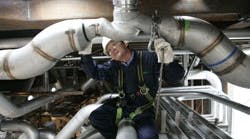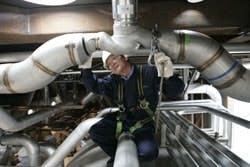Despite the current global economic uncertainties, the demand for chemical engineers seems to be holding up. Some key traditional U.S. employers, such as oil and petrochemical companies and contractors that support them, are adding staff, making up for weakness in other sectors such as pharmaceuticals and fine chemicals. However, jobs are migrating to where markets are strongest and more new plants are going up — particularly China and elsewhere in Asia — as many major firms set up engineering operations nearby.
Meanwhile, the rise of “green” initiatives, such as bio-based manufacturing and renewable energy (www.ChemicalProcessing.com/articles/2008/180.html), are providing opportunities for chemical engineers in these rapidly emerging areas. And nuclear is staging a comeback, with recruiters in both the U.S. and Europe reporting an increase in demand there for chemical engineering skills.
Overlying the changing jobs situation, in the West at least, is a demographic time bomb. With thousands of experienced chemical engineers on the verge of retirement, companies must grapple with how to retain organizational knowledge — and effectively pass it on to the incoming YouTube generation with its very different way of absorbing information.
A Broad Vantage Point
No company can claim to have a comprehensive view of all these issues, but one that comes close is Air Products and Chemicals, Allentown, Pa. With 21,000 workers spread over 600 facilities in more than 40 countries, the firm supplies industrial gases, chemicals and services to almost every major manufacturer.
Figure 1 -- Growing Gas Demand: New technologies
are driving demand for traditional air separation units.
Source: Air Products.
Summarizing the technological situation, Richard O'Reilly, global manager for process technologies and himself a chemical engineer, says: “We are seeing increased demand for tonnage gases such as hydrogen for refinery applications where it’s used to refine heavier feedstocks and help reduce emissions. On top of that, new electronics applications such as photovoltaics demand a lot of specialty gases during the manufacturing process. Demand is even increasing for traditional air separation units (Figure 1) because oxygen is needed by new coal gasification and gas-to-liquid plants.”
O’Reilly cites strong markets for the company’s products and services in Asia, Central/Eastern Europe and the Middle East — plus locations with remote gas fields, where demand for liquefied natural gas (LNG) technology is strong. The importance of such markets and the need for suppliers to get closer to them is well illustrated by Air Products, which already has engineering centers in the U.S., Europe and Asia, and is planning to soon open a fourth one — in Asia.
New applications generally are becoming very targeted, he notes. “Take carbon dioxide capture, for example. We’ve been working on this for 10 to 15 years now and it seems to be coming of age. Although this does depend on what happens in terms of legislation. It could become a huge area for us,” O’Reilly says.
Figure 2. -- In the Vanguard:
Headquarters complex features a hydrogen-powered
shuttle van and refilling station.
Source: Air Products.
The company has an intense research-and-development (R&D) focus on future energy business, especially for hydrogen production, storage and distribution. It recently commissioned a hydrogen fueling station and hydrogen-powered campus shuttle bus at its Allentown headquarters (Figure 2). Air Products has experienced nearly 100% growth in its global hydrogen energy business in 2008.
All these new projects, technologies and services rely on chemical engineers’ skills.
“The chemical engineering discipline finds its way into many positions within the company, from traditional engineering activities, right through to commercial and sales. So it’s a very important discipline for us,” says Robin Lysek, central staffing manager. Management certainly doesn’t require convincing — the current chairman and his predecessor are chemical engineers and both came up through the company’s career development program.
“The basic skills we need as a company are still the same, for example heat and mass transfer, fluid flow and unit operations — skills that chemical engineers have. We are also finding that new graduates are very current with their knowledge, for example of the carbon dioxide issue, and can adapt very quickly to the technological challenges of such issues — which aligns them with our business strategy,” notes O’Reilly.
However, like many other companies, Air Products is facing a demographic headache as veteran technical staff approach retirement. So the company is working hard on succession planning, mentoring and communication sessions to make sure that it doesn’t lose these engineers’ valuable knowledge.
Effectively transferring such information to new engineers requires some adjustments. “You have to understand how the younger ones want to absorb that knowledge. They want everything electronically, so we are looking into different media technologies, for example trying to learn from YouTube/iPod type applications,” says O’Reilly.
“We need to continue to feed our talent pipeline with new chemical engineering graduates and we have plans in place to ensure that the right individuals with the right skills are here at the right time,” adds Lysek.
A Model Response
Process optimization and software services specialist AspenTech, Burlington, Mass., focuses a lot of effort on helping customers replicate real-world conditions in models. However, simulation isn’t the answer for one real-world issue it faces — engineering supply and demand. Nearly half of its 1,400 employees are chemical engineers, all with postgraduate degrees.
“Across our customer base, the feedback is always that there is a shortage of engineers. So it’s definitely a good time for chemical engineers, no question,” says Vikas Dhole, the company’s vice president of engineering product management and a chemical engineer.
“Clearly oil and gas and upstream operations enjoy most capital investment now, while energy is important, too. This, in turn, creates a positive impact elsewhere, for example with LNG and emerging sectors such as coal gasification and tar sands. Despite the fall in oil price, there’s still lots of activity especially in the Middle East, Brazil, China and India,” he adds, noting that a majority of the company’s business now is outside the U.S., with about 30–35% in Europe/Middle East/Africa and 20% to 25% in Asia/Pacific.
AspenTech typifies the trend of moving to where the work is. The company decided to open a center of excellence (COE) for quality assurance in Shanghai; it joins the company’s existing COEs for software development in Burlington, and manufacturing and supply chain R&D in Houston.
“Shanghai has been very successful and is growing rapidly. We also have field resources across the globe in nearly 40 different offices. These include technical consultants, customer support and training, and grow in line with new projects as they develop in different regions,” he says.
Dhole also notes that operating companies like Dow and DuPont have opened engineering centers in China, India and Southeast Asia. “This is a new thing: five years ago it would have been outsourced to a local company. Now the process engineering is actually being executed there. The benefit here is the access to engineering talent — and this will change the dynamics of process engineering execution in the future. For us, it’s a growth opportunity and is definitely a dynamic that the chemical engineering community needs to be aware of.”
AspenTech also is managing a demographic issue — but one with a twist. Formed in 1981, the company has a relatively young workforce; the challenge it faces is with customers.
“I heard recently from an executive at a global E&C [engineering and construction] company who employs thousands of engineers. However, he is still facing a significant shortfall. At the same time, about 30% of his engineers have less than three years’ experience. This is another reason why our training activities are so important — and becoming increasingly more important,” says Sanjeev Mullick, director of product marketing and a chemical engineer.
The challenge here is to help these young users gain knowledge as quickly as possible, one of the drivers behind the company’s simplified “expert in a box” training packages and 90-minute “lunch and learn” sessions.
Like Air Products, Aspen is finding that the YouTube generation want their information in a different way. “They expect more speed and agility from their software than did their predecessors, but at the same time they trust the software much more than their predecessors — which is a double-edged sword, as they tend to trust it too much,” says Dhole. “They are a bit more gullible,” Mullick suggests.
Recruiter’s View
“Our business is highly concentrated in the oil and gas sector, where the issue of matching chemical engineer supply and their demand has been an ongoing, long-term problem. Even with the price of oil falling, I expect this to remain tight for some time yet,” says Tim McAward, vice president of Kelly Services, Troy, Mich., a human resources firm.
This demand very much focuses on chemical engineers needed to carry out design work in the U.S. to support customers in China, India and, increasingly, Brazil. “Long-term, some organizations are looking at the talent they can leverage in the U.S. while building pools of talent abroad — nearer to the shop. So I would expect to see a shifting of this design work from the U.S. to China and India as companies build up bigger resources nearer to the main projects.”
Kelly is seeing increasing business-related to green projects, but one of the big anticipated demand areas is in the nuclear arena. “There hasn’t been a new nuclear power station here for three decades and, as the U.S. really begins to invest in new nuclear facilities, the talent is very scarce, both on the design side and on the environmental engineering aspects,” notes McAward.
British Perspective
Traditional sectors — oil, chemicals and allied products, pharmaceuticals and toiletries, and contracting — remain the key providers of jobs for the 27,000-strong worldwide membership of the Institution of Chemical Engineers (IChemE), Rugby, U.K. “In the grand scheme of things, classical chemical manufacturing and chemical plant design are still the most important on a global scale. All the growth in India and China of ethylene and ammonia plants, for example, still requires the basics,” notes Neil Atkinson, IChemE’s director, qualifications and international development.
“However, Western chemical engineering is definitely moving more towards the bio-interfaces than in the past. By this I mean the inclusion of biology and biological processes into our discipline,” he adds. As evidence of this, he cites the August merger of the Department of Chemical Engineering and the Institute of Biotechnology at Cambridge University, Cambridge, U.K., into the new Department of Chemical Engineering and Biotechnology. Similar mergers or renaming of chemical engineering departments to emphasize biotechnology have taken place in the U.S.
Welcoming the move, chemical engineering department head Professor Lynn Gladden pointed to the increasing overlap in research interests and collaborations between the two departments. “Chemical engineering recognized that it did not have the breadth of expertise in relevant biological subjects to capitalize on research opportunities in bio-energy, biopharmaceuticals and bioproduct engineering,” she noted.
In an echo of what’s being seen in the U.S., the importance of such opportunities already is beginning to bear fruit for the U.K.’s recruitment sector.
“Up until recently, oil and gas has been a very, very strong sector for recruitment,” says Lee Knowles, director with recruitment company NES U.K., Newcastle Upon Tyne, near the heart of Britain’s chemical manufacturing region. “This was driven by the huge projects announced on the back of the high oil price. A lot of the design work for these projects came into contracting companies in the U.K. ... You have to remember that a big oil and gas project these days can be worth £500 million [around $750 million] and need up to 200 design engineers. A big pharma project, on the other hand, might be worth £75m [about $115 million] and only need 20 chemical engineers at its peak,” explains Knowles, who is responsible for the company’s specialist chemical engineering and validation recruitment sector.
He describes the pharmaceutical market as “not too clever just now,” noting that big employers such as GSK and Novartis are cutting back on primary manufacturing. In addition, general chemical manufacturing remains poor, with overseas competition leading to the closure of a host of well-known batch and fine chemical companies in the Leeds and Bradford regions of Northern England.
On the other hand, NES is seeing increasing demand for nuclear engineers, many of whom typically have chemical engineering backgrounds. This follows the January invitation by the U.K. government for energy companies to bring forward plans to build and operate new nuclear power stations as part of the country’s strategy to ensure a secure, diverse and low-carbon energy mix.
The importance of this was emphasized in mid-November when Babcock International, London, reported a 30% increase in first-half profits; this included revenues of more than £54 million [about $82 million] from its nuclear business — up 50%. “Five years from now, we are talking big design time on a new generation of stations, so you could see our current business double,” said chief executive Peter Rogers.
Meanwhile, Knowles describes the biofuels situation as mixed, with a number of companies pushing ahead with projects while others are biding their time to see how government responds to the food/fuel debate on the use of crops. “On the other hand, the interest in biofuels has driven demand for agrochemicals, so companies such as Bayer and Syngenta are doing very well because of the demand for their products,” he notes.
Knowles also points to a dramatic change in the role of chemical engineering contractors. “Up to 12 months ago we had the situation where four or five big companies were winning huge contracts in the oil sector. Traditionally, experienced contractors have been used to even out demand spikes, but this one was massive. So all sorts of people were taken on as contractors who might not have been years ago: they were drawing from nuclear, pharma and water management, which rarely happened in the past.”
This meant that a lot of people were going into contracting much earlier in their careers, he explains. “So now we are finding that these contractors are coming back on the market with only two, three or four years experience, which isn’t really enough for the major employers. So they are now searching for permanent jobs again.”
Overall, 2008 was NES’s best year ever for permanent employment. “Demand is still high, especially as companies are now looking at more strategic employment, which means more permanent staff are being taken on.”
Seán Ottewell is Editor at Large for Chemical Processing. You can e-mail him at [email protected].




